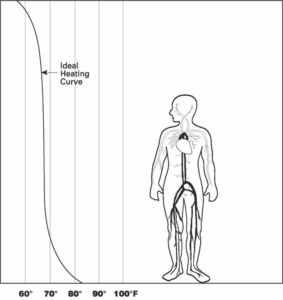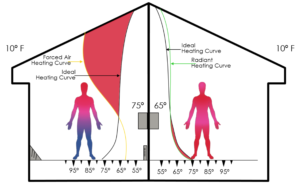By Steve Swanson
Currently in the U.S., 95% of all new homes are built with forced-air heating systems (the other 5% are built with hydronic heating or electric heat). This is a classic David and Goliath situation. Now, just from the numbers, you would think forced air is a superior or better method for conditioning a home. Maybe not though. A brief history of heating may help.
Our country started heating its homes with wood, wood fireplaces in particular. In 1741, Benjamin Franklin invented the Franklin Stove that surrounded the fire with cast iron that greatly increased the heat output and reduced the smoke that came into the home. It also stopped many homes from spontaneously combusting which greatly helped our country grow in numbers. New designs followed that added a cook stove to the fireplace, so now people could heat their homes and cook their meals all in one unit. Clever.
By the second half of the 1800s, cast iron radiators showed up on the scene with boilers in the basement fueled by coal and, for the first time, coal surpassed wood as the fuel of choice. Unfortunately, the boilers didn’t have the safety features that today’s equipment has and they had the peculiar habit of relocating themselves due to boiler explosions — meaning perhaps to the opposite side of the city. Occasionally, in the late 1800s, you would be walking down the sidewalk minding your own business and you might see a boiler launch out of a house and relocate itself to another community. Not good for business.
Then along came Dave Lennox in 1885 who invented the first coal-fired furnace that used coal as a heat source. They didn’t have fans, because they didn’t have electricity, so the first furnaces relied on convection heat through gigantic ducts to carry heat around the house. The ducts often took as much space as the house itself. But, at least the furnaces stayed in the house.
In the 1930s, furnaces began incorporating electric fans which greatly reduced duct sizing and improved efficiency. Oil- and gas-fired furnaces replaced coal because nobody wanted to go down into the coal bin in the middle of the night to shovel half a ton of coal into the coal feeder. This, in turn, resulted in a significant decrease in the divorce rate around the U.S. and all hailed it as a marvel of engineering, which brings us to today.
The problem with forced air is that it is “forced” air. The name itself should be a tipoff that something isn’t right. And it’s true. Air is a horrible conductor of heat. Water can carry 3,500 times more energy than the same amount of air. In an age of sustainability and concern for energy usage, using air to move heat is like picking up your groceries with a semi-truck. And that isn’t even the whole issue.
Air, when you heat it, has a tendency to rise. Up to the ceiling. Terrific. Now my ceiling is toasty and my toes are frosty. This is the story of forced-air homes. Every forced air home I have ever been in has one thing in common: a blanket on the couch. Why? Because hot air rises and cold air sinks. Your couch is sitting in the sink area and you feel colder. So you put on a blanket.
Now why in the world would you need a blanket to keep you warm in your own living room? Isn’t that the job of the furnace and the thermostat? Which reminds me. Where is the thermostat anyway? Oh, that’s right. It’s in the hallway. Where no one lives. Our houses have one thermostat and my car has three. One for the driver, one for the passenger and one for the back seat. Go figure. Let me show you something else.
Way back in the 1940s, the Bell & Gossett Company studied thousands of people to determine what made them comfortable (not counting two weeks in Hawaii). From that came what we know today as the ideal comfort curve (see Figure 1). This is the temperature comfort curve for more than 95% of people.
As you can see from the graph, if our feet were at about 73°F and our head was at about 68°F, 95% of most people would be comfortable. (The other 5% are like my Aunt Lucy who just like to complain.)
Now if we compare the ideal comfort curve to the heat output of both a forced-air system and a radiant system, we will see something very revealing (see Figure 2).
The ideal comfort curve would like my toes to be at 73°F and my head to be at 68°F. Instead, with forced-air heat, my feet are at 63°F and my head is exploding. Forced-air heat provides not enough heat where I need it and too much where I don’t need it. So, to compensate, people put carpet on the floor and ceiling fans on the ceiling.
Wherever the real curve is outside of the ideal curve you are wasting energy and you feel less comfortable. The wider the difference, the worse it is. And yet radiant heat is almost identical to the ideal comfort curve!
Now, you’re probably saying to yourself, “What about the extra cost of installing radiant heating and what about air conditioning?” Well, one way or another, you are going to pay for a radiant heating system. You are either going to pay for it up front and enjoy the enormous comfort difference, or you are going to pay for it later due to higher energy bills. It’s that simple. And as for air conditioning, I’ll save that one for another day.
Happy heating!
Steve Swanson is the national trainer at Uponor Academy. He actively welcomes readers’ comments and can be reached at steve.swanson@uponor.com.










Leave a Reply